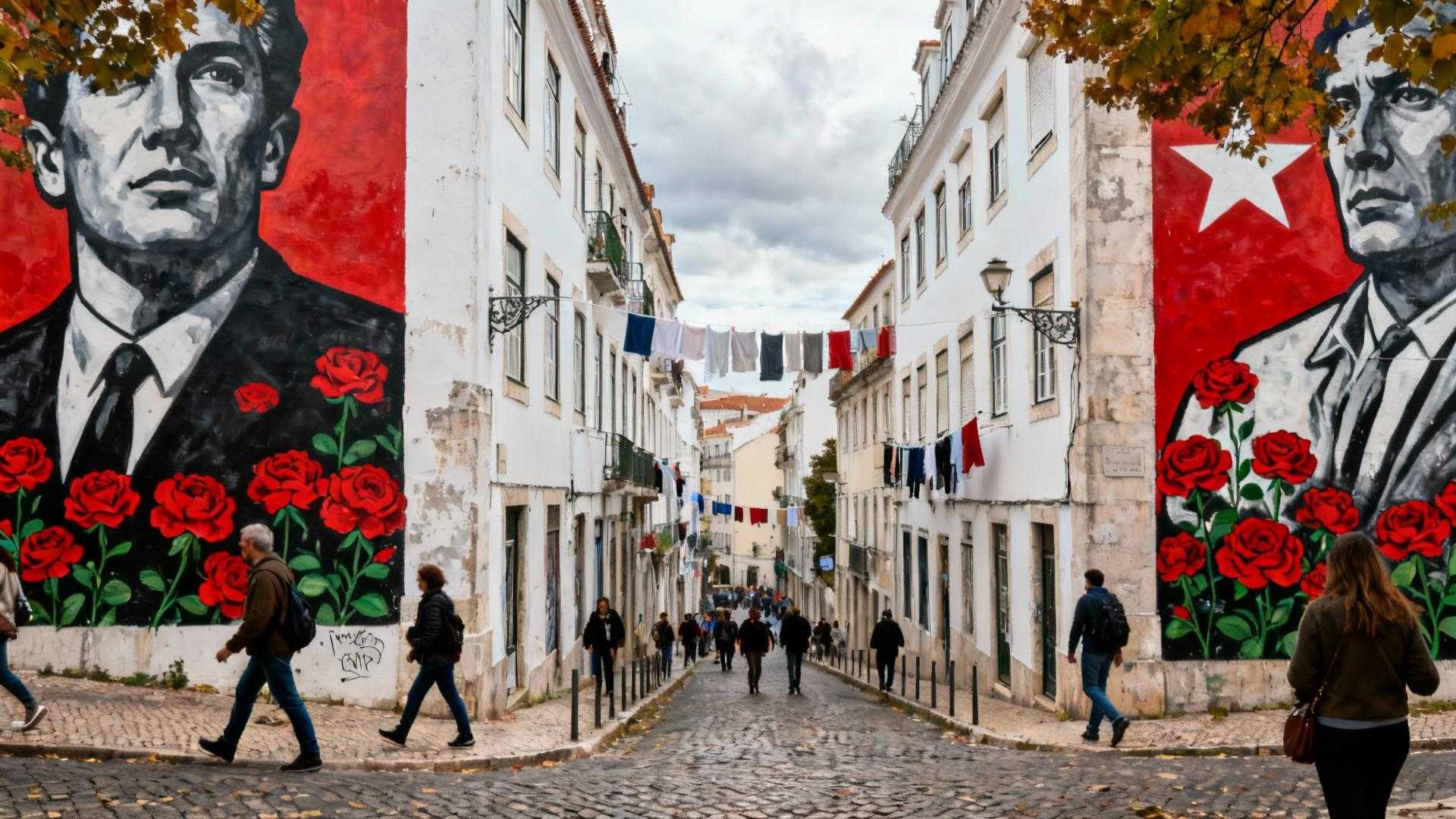I stumbled into Graça on a Tuesday morning when the tour buses were still circling Alfama’s cobblestones three hills away. An elderly woman was hanging laundry across a balcony painted with revolution-red carnations, and behind her, a 20-foot mural of Portugal’s 1974 Carnation Revolution stretched across four stories of peeling plaster. She saw me photographing and shook her head with a smile that wasn’t quite welcoming.
“Os turistas ainda não descobriram,” she said. The tourists haven’t discovered this yet. Her tone suggested she’d prefer keeping it that way.
That’s when I realized I’d found Lisbon’s last authentic hilltop village—a neighborhood where Shepard Fairey’s political murals hide behind residential facades, where 50+ colors of street art cost exactly $0 to experience, and where locals are quietly protective of what mass tourism destroyed in Alfama. Graça sits on Lisbon’s highest hill, a working-class enclave that feels more like a Mediterranean village than a capital city neighborhood. And residents want it to stay that way.
Why Graça’s residents guard their street art village
The working-class history tourists miss
Graça evolved from 19th-century workers’ villas built by industrialists to house factory laborers. Vila Berta and Vila Sousa still stand as tiled examples of this heritage, their narrow lanes preserving a small-town atmosphere where neighbors know each other’s coffee orders. Unlike French coastal villages that transformed into art tourism destinations, Graça maintained its residential character even as street artists discovered its walls.
Locals sit outside to drink coffee while store owners chat from doorways—daily rituals that vanished from Alfama when selfie crowds arrived. The neighborhood’s 40-acre footprint feels intimate compared to sprawling tourist districts, and residents actively discourage the commercialization threatening to follow Instagram’s attention.
The street art that belongs to the community
Walk Caracol da Graça or Rua da Senhora da Glória and you’ll find murals that weren’t commissioned for tourists—they were painted for neighbors. Shepard Fairey’s Carnation Revolution tributes honor Portugal’s 1974 democratic uprising with the same political weight he brought to his Obama “Hope” poster. These aren’t Instagram backdrops; they’re cultural statements residents want protected from commodification.
The YesYouCanSpray project recently added cohesive visual stories blending elderly residents’ portraits with revolutionary history. Artists like Regg Salgado and Mariana Duarte Santos work through G.A.U. (Galeria de Arte Urbana) to create pieces that reflect community identity rather than tourist appeal. Locals fear the trajectory that transformed Miami’s Wynwood from neighborhood to Instagram hotspot.
What makes Graça different from Alfama’s tourist circus
The authenticity advantage tourists overlook
Alfama processes thousands of daily visitors through fado restaurants and tuk-tuk routes. Graça sees a fraction of that traffic, which preserves the lived-in atmosphere where residents outnumber tourists 10-to-1. Dining costs average 30% less than Alfama’s inflated tourist prices, and you’ll eat alongside Portuguese families rather than tour groups.
The neighborhood’s two miradouros—Graça and Senhora do Monte—offer identical Tagus River views without Alfama’s crowds. Senhora do Monte sits atop Lisbon’s highest hill at 85 meters, a romantic sunset spot locals reclaim after tour buses depart at 6pm.
The street art diversity commercial districts can’t match
While LX Factory curates Instagram-ready murals for €20 tour tickets, Graça’s art spans stencils to four-story murals scattered through residential streets. You’ll find work from Seb Bouchard near Rua Damasceno Monteiro, political pieces in hidden corners, and painted shutters that residents commissioned themselves.
This organic diversity beats Bairro Alto’s commercial street art—and unlike medieval French villages protecting religious heritage, Graça’s residents protect living cultural expression. The “wild, dynamic mess” older residents remember from the early 2010s has matured into sophisticated community art without losing its edge.
How to experience Graça before Instagram arrives
The respectful exploration locals appreciate
Visit during October’s golden hour when temperatures hover around 68°F and fewer tourists crowd Lisbon. Start at Igreja da Graça in late afternoon, then wander Caracol da Graça’s residential lanes where murals hide between laundry lines. Support neighborhood tascas (traditional taverns) rather than tourist restaurants—your €8 lunch funds the community residents want preserved.
Photograph murals respectfully without disrupting daily life. Locals tolerate curious visitors but resent loud groups treating their neighborhood like a theme park. Learn basic Portuguese phrases; even “obrigado” acknowledges you’re a guest in someone’s home rather than a consumer in a tourist product.
The timing that matters for preservation
Graça faces development pressures similar to what gentrified Intendente and Mouraria. Residents fear that by 2026, rising rents and tourist accommodations will displace the families who give this neighborhood its soul. Visit now while community-driven art still outnumbers commercial murals, while tascas still serve neighbors before tourists, while that elderly woman can still hang laundry beneath revolution-red carnations without tour groups photographing her daily routine.
The secret isn’t the street art itself—it’s the living neighborhood context that makes these murals meaningful. And that’s exactly what locals don’t want Instagram crowds to discover and destroy.
Frequently asked questions about Graça’s street art
Is Graça safe for tourists to explore independently?
Graça is safer than Mouraria and equally safe as Alfama during daylight hours. The residential character means locals notice strangers, which actually enhances safety. Avoid wandering isolated areas after dark, stick to main streets like Rua da Graça and Rua da Senhora do Monte, and you’ll encounter no issues beyond occasional hills requiring stamina.
Can I take guided street art tours in Graça?
Small-scale walking tours exist through local guides specializing in urban art, but mass tour companies haven’t commodified Graça yet—which residents prefer. Independent exploration respects neighborhood character better than large groups disrupting residential streets. Use online resources to map murals rather than joining tours that accelerate the over-tourism locals fear.
How does Graça compare to LX Factory for street art?
LX Factory offers curated commercial murals in a former industrial complex charging admission for events. Graça provides organic community art free to experience throughout residential streets. LX Factory feels like an outdoor gallery; Graça feels like a neighborhood where art happens naturally. The authenticity difference is substantial, and locals want to preserve that distinction before commercial interests arrive.
